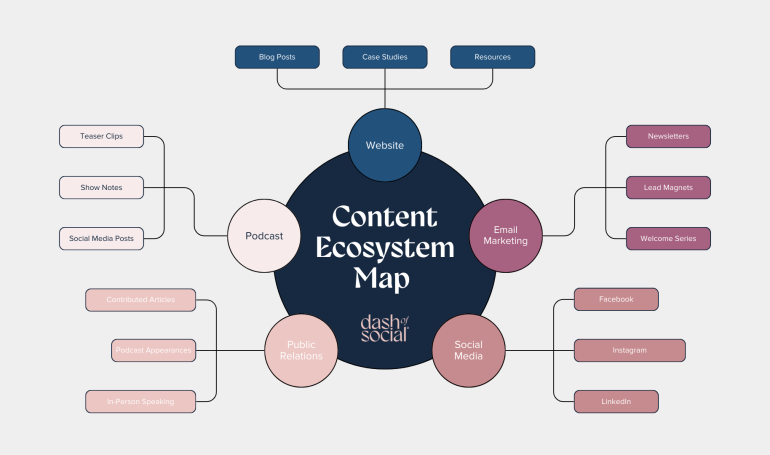
How to Build a Content Ecosystem Map and Why You Need One
Having a strategic approach to content creation and distribution is essential. Without a clear structure, businesses often struggle with disjointed messaging, wasted resources, and missed opportunities to engage their audience effectively. A content ecosystem map helps address these challenges by providing a visual representation of how content flows across different channels and touchpoints. This structured approach ensures that every piece of content serves a purpose and contributes to overarching business goals.
What Is a Content Ecosystem Map?
A content ecosystem map is a visual representation of how all your content assets connect and interact across various platforms, channels, and audience touchpoints. It provides a strategic overview of your content distribution, showing where and how content flows, what formats are used, and how different pieces support each other to engage your audience and drive business goals.
Think of it as a blueprint for your content strategy that works to ensure your efforts are structured, cohesive, and purposeful.
Why Do You Need a Content Ecosystem Map?
Creating a content ecosystem map is necessary for several reasons:
Clarity and Alignment
It helps align your content efforts with business goals by ensuring that every piece of content serves a purpose within your broader strategy.
Efficiency and Optimization
By mapping out content pathways, you can identify gaps, redundancies, and opportunities for repurposing existing content to maximize efficiency.
Improved Audience Engagement
Understanding how your audience interacts with different content touchpoints allows you to craft more personalized and effective messaging.
Cross-Channel Cohesion
It ensures that your content efforts across social media, blogs, email marketing, and other platforms work together rather than in silos.
Performance Tracking
A well-structured content ecosystem makes it easier to measure performance, optimize strategies, and improve ROI over time.
How to Create a Content Ecosystem Map
Step 1: Define Your Goals
Start by identifying what you want to achieve with your content. Your objectives could include:
- Increasing brand awareness
- Generating leads
- Educating customers
- Driving website traffic
- Nurturing customer relationships
Having clear goals will shape how you structure your content ecosystem.
Step 2: Identify Your Core Content Hubs
Your core content hubs are the primary sources where your content originates. These often include:
- Website & Blog – The home of in-depth articles, case studies, and pillar content.
- Social Media Channels – Platforms for audience engagement, distribution, and brand storytelling.
- Email Marketing – Newsletters, drip campaigns, and direct audience nurturing.
- Video & Podcast Platforms – Long-form and visual content channels such as YouTube, webinars, and podcasts.
Understanding your content hubs helps you map out the content’s movement across different touchpoints.
Step 3: Outline Your Content Types
Identify the various formats of content you produce. This can include:
- Blog posts
- Videos
- Infographics
- E-books
- White papers
- Social media posts
- Case studies
- Webinars
Recognizing content types helps in structuring how different formats interconnect within the ecosystem.
Step 4: Map Out Content Flow and Distribution
This step involves visually mapping how content moves across your ecosystem. Ask yourself:
- Where does each content piece originate?
- How is it repurposed and adapted for different platforms?
- What are the primary distribution channels?
- How does content guide users along their journey?
For example, a blog post might be repurposed into a series of LinkedIn posts, an email newsletter, an infographic, and a short-form video for Instagram.
Step 5: Connect Audience Touchpoints
Your content ecosystem should align with audience behavior. Map how different audience segments engage with content at various stages of their journey. Consider:
- Awareness stage (social media, blog articles, videos)
- Consideration stage (case studies, webinars, comparison guides)
- Decision stage (testimonials, product demos, in-depth whitepapers)
Understanding audience pathways allows for a seamless content experience.
Step 6: Integrate Measurement and Optimization
No ecosystem is complete without analytics. Ensure your map includes:
- Key performance indicators (KPIs) for each channel
- Tracking tools (Google Analytics, social media insights, email performance metrics)
- Feedback loops for continuous optimization
This will help you get an understanding of what’s working and what isn’t so you can make adjustments moving forward, as needed.
What Should Your Content Ecosystem Map Include?
A comprehensive content ecosystem map should include:
- Content sources (where content originates)
- Distribution channels (how and where content is shared)
- Audience touchpoints (how different audience segments engage with content)
- Repurposing pathways (how content is adapted and repurposed)
- Engagement loops (how content encourages interaction and further engagement)
- Analytics integration (how success is measured)
When you tie everything together, you’ll be left with an easy-to-follow visual that several team members will be able to collaborate on and implement.
Building Your Content Ecosystem Map
It’s important to note that your content ecosystem map will evolve with your business and audience needs. By creating a clear, structured approach to content distribution, you ensure that your marketing efforts are intentional, efficient, and ultimately more successful.
If you’re looking to build this out for your company, we’re here to help. Request a consultation with us today.
